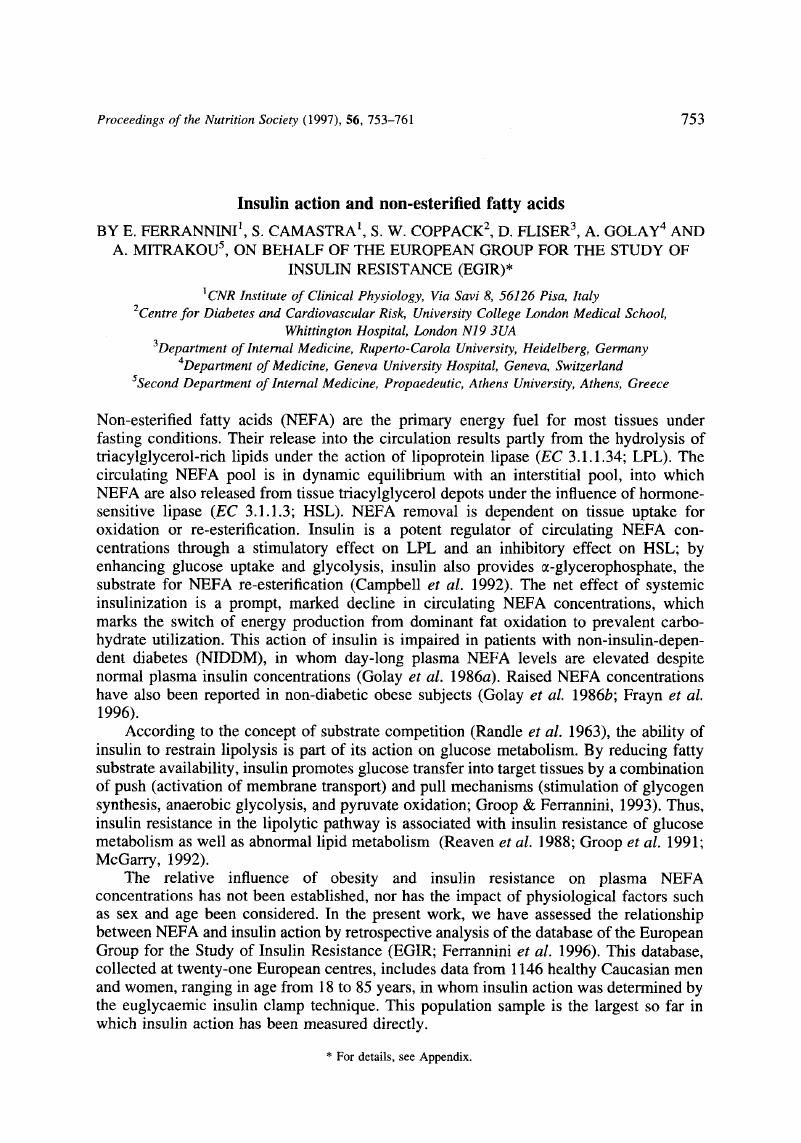Crossref Citations
This article has been cited by the following publications. This list is generated based on data provided by Crossref.
Ferrannini, Ele
1998.
Insulin Resistance versus Insulin Deficiency in Non-Insulin-Dependent Diabetes Mellitus: Problems and Prospects.
Endocrine Reviews,
Vol. 19,
Issue. 4,
p.
477.
Byrne, C. D.
Maison, P.
Halsall, D.
Martensz, N.
Hales, C. N.
and
Wareham, N. J.
1999.
Cross‐sectional but not longitudinal associations between non‐esterified fatty acid levels and glucose intolerance and other features of the metabolic syndrome.
Diabetic Medicine,
Vol. 16,
Issue. 12,
p.
1007.
Minihane, AM
Khan, S
Talmud, PJ
Williams, DL
Wright, JW
Murphy, MC
Griffin, BA
and
Williams, CM
2000.
Lack of association between lipaemia and central adiposity in subjects with an atherogenic lipoprotein phenotype (ALP).
International Journal of Obesity,
Vol. 24,
Issue. 9,
p.
1097.
Frape, D. L.
Williams, N. R.
Carpenter, K. L. H.
Freeman, M. A.
Palmer, C. R.
and
Fletcher, R. J.
2000.
Insulin response and changes in composition of non-esterified fatty acids in blood plasma of middle-aged men following isoenergetic fatty and carbohydrate breakfasts.
British Journal of Nutrition,
Vol. 84,
Issue. 5,
p.
737.
Evans, Alison J.
and
Krentz, Andrew J.
2001.
Insulin resistance and β‐cell dysfunction as therapeutic targets in type 2 diabetes.
Diabetes, Obesity and Metabolism,
Vol. 3,
Issue. 4,
p.
219.
Ferrannini, E.
and
Balkau, B.
2002.
Insulin: in search of a syndrome.
Diabetic Medicine,
Vol. 19,
Issue. 9,
p.
724.
Lovegrove, J A
Brady, L M
Lesauvage, S V M
Lovegrove, S S
Minihane, A M
and
Williams, C M
2003.
Lack of association between central adiposity and lipaemia in UK Sikh men.
International Journal of Obesity,
Vol. 27,
Issue. 11,
p.
1373.
Hills, S. A.
Balkau, B.
Coppack, S. W.
Dekker, J. M.
Mari, A.
Natali, A.
Walker, M.
and
Ferrannini, E.
2004.
The EGIR-RISC STUDY (The European group for the study of insulin resistance: relationship between insulin sensitivity and cardiovascular disease risk): I. Methodology and Objectives.
Diabetologia,
Vol. 47,
Issue. 3,
p.
566.
Ferrannini, Ele
Camastra, Stefania
Gastaldelli, Amalia
Sironi, Anna Maira
Natali, Andrea
Muscelli, Elza
Mingrone, Geltrude
and
Mari, Andrea
2004.
Beta-Cell Function in Obesity.
Diabetes,
Vol. 53,
Issue. suppl_3,
p.
S26.
Camastra, Stefania
Manco, Melania
Mari, Andrea
Baldi, Simona
Gastaldelli, Amalia
Greco, Aldo V.
Mingrone, Gertrude
and
Ferrannini, Ele
2005.
β-Cell Function in Morbidly Obese Subjects During Free Living .
Diabetes,
Vol. 54,
Issue. 8,
p.
2382.
Ferrannini, Ele
2006.
Is insulin resistance the cause of the metabolic syndrome?.
Annals of Medicine,
Vol. 38,
Issue. 1,
p.
42.
Moate, Peter J
Roche, John R
Chagas, Lucia M
and
Boston, Raymond C
2007.
Evaluation of a compartmental model to describe non-esterified fatty acid kinetics in Holstein dairy cows.
Journal of Dairy Research,
Vol. 74,
Issue. 4,
p.
430.
Boston, Ray C.
and
Moate, Peter J.
2008.
A novel minimal model to describe NEFA kinetics following an intravenous glucose challenge.
American Journal of Physiology-Regulatory, Integrative and Comparative Physiology,
Vol. 294,
Issue. 4,
p.
R1140.
Trapp, E G
Chisholm, D J
Freund, J
and
Boutcher, S H
2008.
The effects of high-intensity intermittent exercise training on fat loss and fasting insulin levels of young women.
International Journal of Obesity,
Vol. 32,
Issue. 4,
p.
684.
Roche, J.R.
Sheahan, A.J.
Chagas, L.M.
and
Boston, R.C.
2008.
Short Communication: Change in Plasma Ghrelin in Dairy Cows Following an Intravenous Glucose Challenge.
Journal of Dairy Science,
Vol. 91,
Issue. 3,
p.
1005.
Boston, Raymond C
Roche, John R
Ward, Glen M
and
Moate, Peter J
2008.
A novel minimal model to describe non-esterified fatty acid kinetics in Holstein dairy cows.
Journal of Dairy Research,
Vol. 75,
Issue. 1,
p.
13.
Karakas, Sidika E.
Almario, Rogelio U.
and
Kim, Kyoungmi
2009.
Serum fatty acid binding protein 4, free fatty acids, and metabolic risk markers.
Metabolism,
Vol. 58,
Issue. 7,
p.
1002.
Thompson, A. K.
Newens, K. J.
Barton, M. T.
Jackson, K. G.
and
Williams, C. M.
2010.
Impact of elevated NEFA on incretin hormone levels and insulin metabolism.
Proceedings of the Nutrition Society,
Vol. 69,
Issue. OCE1,
Camastra, S.
Gastaldelli, A.
Mari, A.
Bonuccelli, S.
Scartabelli, G.
Frascerra, S.
Baldi, S.
Nannipieri, M.
Rebelos, E.
Anselmino, M.
Muscelli, E.
and
Ferrannini, E.
2011.
Early and longer term effects of gastric bypass surgery on tissue-specific insulin sensitivity and beta cell function in morbidly obese patients with and without type 2 diabetes.
Diabetologia,
Vol. 54,
Issue. 8,
p.
2093.
Haramizu, Satoshi
Shimotoyodome, Akira
Fukuoka, Daisuke
Murase, Takatoshi
and
Hase, Tadashi
2012.
Hydroxypropylated distarch phosphate versus unmodified tapioca starch: fat oxidation and endurance in C57BL/6J mice.
European Journal of Applied Physiology,
Vol. 112,
Issue. 9,
p.
3409.



